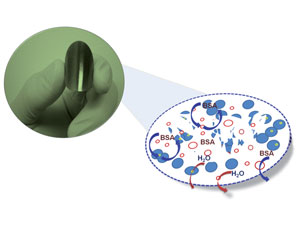Scientists in China have developed a polymer scaffold for functional nanoparticles that can be folded and mangled but will reform into its original shape if it is placed in water.
Materials often exhibit very different properties when shrunk down to the nanoscale. Exciting new devices can be designed when nanoscale characteristics are brought together in synergy with macroscale materials, but bespoke production processes are often needed for each new nano-composite material.
Shu-Hong Yu and colleagues at the University of Science and Technology of China have developed a simple shape memory polymer scaffold from chitosan that can be used as a host for a wide range of different functional nanoparticles, combining benefits from the macro- and nanoscale.
Huai-Ling Gao, Yang Lu, Li-Bo Mao, Duo An, Liang Xu, Jun-Tong Gu, Fei Long and Shu-Hong Yu
Mater. Horiz., 2014, Advance Article
DOI: 10.1039/C3MH00040K











